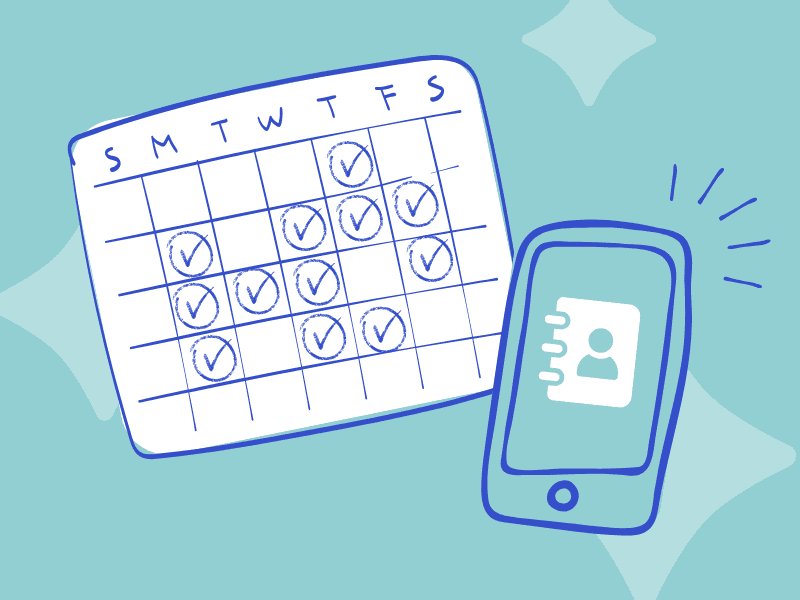Part of a successful multi-location dental marketing strategy is ensuring every call gets answered. While online forms have their place, phone calls are by far the most valuable type of lead your practice can receive. Unlike form submissions, which convert at an average of just 2%, phone calls convert at 25–40%, making them 12 to 20 times more effective for driving new patient appointments.
Phone calls offer a direct, personal connection. When a potential patient picks up the phone, they’re often ready to act. With a well-prepared team, these warm leads can be nurtured in real time—answering questions, building trust, and securing appointments on the spot.
But these opportunities aren’t guaranteed. Even high-intent callers can be lost if calls aren’t managed effectively. Long hold times, inconsistent messaging, or missed calls can quickly erode trust and drive patients to competing practices.
In this blog, we’ll share five proven ways group practices and DSOs can optimize their call handling process so you can ensure every lead gets the right attention and more conversations turn into loyal patients.
Tip #1: Train Front Desk & Call Center Teams on Active Listening

As the first voices patients hear when they reach out to your practices, front desk and call center teams need to be welcoming, informative, and able to ease concerns. Ensuring you make a good first impression is important as it often determines whether a lead converts to a new patient.
The Role of Tone and Empathy in First Impressions
Visiting the dentist is essential for maintaining one’s oral health, and for some, it can be a stressful experience (e.g., anxious about costs or pain, embarrassed about the state of their oral health). Active listening, combined with empathy and professionalism, sets the tone for a positive patient experience from the start.
Encourage your team to:
- Smile: People can hear when someone is smiling in their voice.
- Use the caller’s name: Do it early and often to make the interaction feel personal.
- Acknowledge emotions: If a patient sounds nervous, saying something like “I understand. Many of our patients feel the same way.” can ease tension.
When patients feel understood and respected, they’re far more likely to move forward with booking an appointment.
Simple Qualification Questions That Save Time and Boost Conversions
By training your team to ask a few simple, qualifying questions, you can create a smoother scheduling process for both patients and staff:
- What’s the reason for your call today?
- Do you have any availability preferences?
- When was your last dental appointment?
- Are there any medical issues we should be aware of?
- What kind of insurance coverage do you have?
These questions not only help the front desk schedule appropriately, but they also give your clinical team a heads-up before the patient even arrives. And because the caller feels that their needs are being carefully noted, it builds confidence that they’re in good hands.
Tip #2: Implement Call Tracking and Recording
You can’t improve what you don’t measure. Using tracking tools can provide valuable insights into your performance, such as where exactly prospective patients are dropping off, conversion rates, and how to improve the new-patient experience.
Eliminate Hold Times to Keep Leads Engaged
One of the fastest ways to lose a potential patient is to keep them on hold. Whether they’re anxious, short on time, or shopping around for the best option, if they wait too long on the phone, they’ll just hang up and move on to the next practice.
By monitoring call data, you and your staff can identify when hold times are spiking and take steps to address the issue, such as adding staff during peak hours or using an AI receptionist for overflow. This simple adjustment helps you maximize the value of every marketing dollar by reducing the number of missed or abandoned calls. For tips on monitoring peak times and managing busy periods, continue reading as we delve into greater detail about this later in the blog.
Pinpoint Conversion Bottlenecks
With call tracking, you can review your data to identify exactly where patients might be getting stuck in the process.
- Are callers dropping off when you encourage them to book an appointment?
- Is the front desk struggling to handle multiple calls at once?
- Do certain team members convert more leads than others?
By listening to call recordings, you gain insight into how your team communicates and whether they’re following best practices. This makes coaching more effective and allows you to fine-tune scripts, improve training, and ultimately book more appointments.
Did you know? Members of our pay-per-call program get a user-friendly call dashboard that provides live recordings of every call and shows real-time performance for calls we connect.
Tip #3: Standardize Call-to-Appointment Scripts
Using call scripts for the most common scenarios saves you time and ensures you deliver consistent messaging to your patients. They give staff control of the conversation. Without one, calls can easily veer off track and lead to long hold times, missed information, or unbooked appointments.
How to create high-performing scripts
- Keep it Short and Simple: Focus on answering questions and resolving issues as quickly as possible. Use conversational language and avoid jargon or overly clinical terms.
- Start with a Warm, Professional Greeting: Use a consistent opener such as, “Good morning, thank you for calling [Practice Name]. This is [Your Name]. How may I help you today?”
- Personalize the call: No two patients are the same. When writing your call scripts, consider the particular needs of your patients and tailor your scripts accordingly. For example, a script for a new patient with insurance questions will differ from one for an existing patient that needs urgent care.
- Use “Confident Closes” to Encourage Booking: Get specific. For example, “We have an opening on Thursday at 3 p.m. Should I reserve that spot for you?”
- End with a Positive and Clear Message: Confirm appointment details (time, provider, location), provide next steps, and thank them.
- Test and Refine Based on Call Recordings: By listening to real patient calls, your team can identify what works and what causes drop-offs.
How to train your team to be consistent and in control of the conversation
Simply handing off scripts to staff isn’t enough; training and practice are what make scripts effective. To maximize the effectiveness of your call scripts, encourage your staff to:
- Role-play calls so your staff can get comfortable with the flow and wording.
- Adapt their tone to each caller while still following the script’s structure.
- Listen actively so the conversation feels natural, not scripted.
- Practice the “confident close”, which consists of ending calls with a clear invitation to book.
By standardizing scripts, you set your team up for consistency, efficiency, and higher conversions—turning more first-time callers into long-term patients.
Note: while call scripting is important, it’s meant to guide conversations, not dictate them. Your staff should still have a deep understanding of your services and processes to answer more complex inquiries where using a script isn’t possible.
Tip #4: Monitor Peak Call Times and Staff Accordingly

Even the most skilled front desk team can only handle so many calls at once. If a new patient dials in during a busy period and can’t reach someone, there’s a good chance they’ll hang up and try the next practice. By monitoring peak call times and staffing accordingly, you can reduce missed opportunities, keep patients happy, and maximize the return on your multi-location dental marketing investment.
Tools to track multi-location call performance
Understanding when and where calls are coming in is essential. Use call tracking tools that show you daily and hourly call volumes by location, so you know exactly when patients are most likely to reach out. This makes it easier to schedule your staff strategically. For example, having extra team members on phones during weekday lunch hours or after work, when new patients are more likely to call.
Consider AI Reception Support
If your practice can’t guarantee someone will always be available to answer in real time, consider an AI receptionist. AI solutions can answer basic questions, capture caller information, and even schedule appointments, ensuring that no potential patient slips through the cracks. AI is a powerful safety net for high-volume periods. Remember, it should complement, not replace, human connection.
Making a plan for peak call times
Once you know your busiest windows, you can create a plan to ensure no call goes unanswered by doing the following:
- Adjust staffing schedules: This ensures more team members are available during high-volume periods.
- Cross-train staff: You’ll have more people available to cover phones when needed.
- Set up overflow protocols: For example, automatically routing calls to another location if one office is overwhelmed.
Tip #5: Minimize Missed Calls
Every missed call is a missed opportunity. Whether it’s a first-time patient looking for a new provider or an existing patient with an urgent concern, not answering the phone can cost your practice both revenue and trust. With the right systems in place, you can drastically reduce the number of calls that slip through the cracks.
Using AI to Reduce Risk
Even the most efficient teams will miss calls from time to time, especially during lunch breaks, after hours, or when multiple lines are ringing at once. AI reception tools can serve as a backup, answering basic questions, capturing patient information, and even scheduling appointments. This ensures that patients are always greeted professionally, rather than being sent to voicemail.
Setting up re-call processes
If you do miss a call, what matters is how quickly you follow up. Create a clear process for returning calls:
- Prioritize missed calls from new patients: They’re often shopping around and may call multiple practices.
- Respond within the same business day whenever possible: People are busy, and with so many options available to them, they may forget about your practice if you don’t get back to them quickly enough.
- Use call logs or alerts: This ensures that no number slips through the cracks.
This proactive approach signals to patients that their needs matter, even if you couldn’t answer in the moment.
Best follow-up script for high conversions
When calling back a missed lead, use a script that’s empathetic, professional, and focused on booking right away:
“Hi [Name], this is [Your Name] from [Practice]. I saw we missed your call earlier, and I wanted to follow up right away. How can I help you today?”
From there, move into qualification questions and offer the soonest available appointment. Ending with a confident close, such as, “We can get you in on [day/time]. Should I reserve that for you?” helps turn missed opportunities into booked patients.
Turn Every Call Into a Growth Opportunity
For group practices and DSOs, phone calls are where real conversions happen. With patients up to 20 times more likely to book through a call than a form, every interaction is a chance to grow your practice and strengthen patient relationships.
By training your teams on active listening, tracking and analyzing calls, standardizing scripts, planning for peak times, and minimizing missed opportunities, you create a system where every lead gets the attention they deserve.
Practices that excel at call management don’t just capture more leads; they increase marketing ROI across all locations and build patient trust from the very first hello. With the right tools and processes in place, your team can ensure every call turns into a meaningful opportunity.



